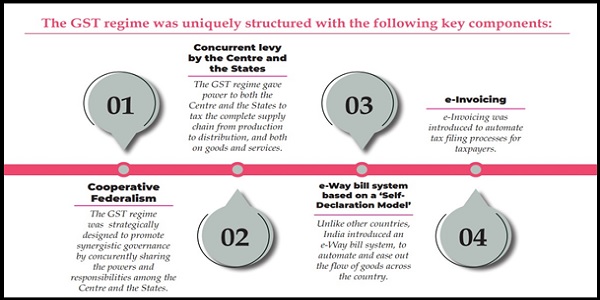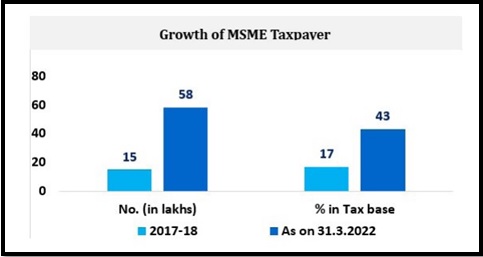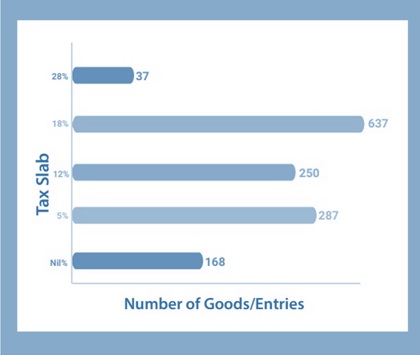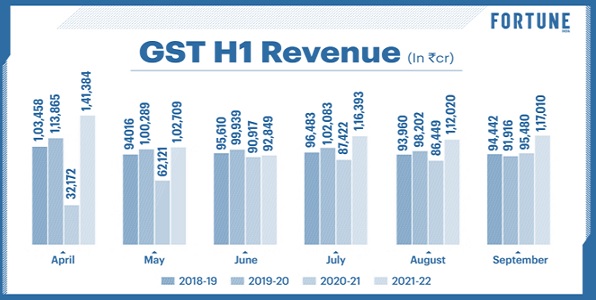TAXO GST 360 – A Next-generation solution for GST organized an Annual Conference with the title, “Unravelling 5 Years of GST – Unlocking India’s Potential” in New Delhi participated by eminent leaders from the industry.
The conclave addressed multiple issues like the Sectoral Review of GST, ease of doing a business review of GST, managing GST Litigations, and bracing GST for the Digital economy. Apart from various technical aspects discussed, the conference appreciated various impetus given by GST to the growth of the Indian Economy.
Experience in implementing GST in the last 5 years
The indirect tax regime underwent a major revolution on July 1, 2017, and introduced the Goods and Services Tax (GST) for the industry which has modernized the entire indirect tax structure of India. The past five years were like a roller coaster ride for both the taxpayers and tax authorities.
“One nation One tax” was the motto of the implementation of the GST Act which has helped in binding the country’s tax system. Automation of tax recording and reporting made a favourable impact on the industry, especially MSMEs. Supply chain activities improved the business prospects leading to an increase in GST collection. Cascading effect of taxes has been removed. The proactive steps were taken by council members aided to overcome initial glitches. “Indian tax transformation” was applauded worldwide.
It resulted in ease of doing business, enhanced productivity, and promoted transparency in business. Even small businesses are enrolled under GST. Still, there is room for improvement to make it a flawless Indian indirect tax structure.

Source: Ministry of Finance
Key challenges and learnings
The foremost challenge of changing GST on the industry is multiple tax rates which are hampering the progress of the country. It is affecting poorer sections of society.
Excessive issuance of show cause notices is increasing hardships for the industry to cope up with other major business issues.
Footwear Industry
The footwear industry is experiencing difficulties in terms of getting GST refunds, application of GST rates, and errors in tax compliance of many unorganized players. However, the growth of the footwear sector is expanding and exports of non-leather products are increasing massively.
Financial Services Sector
GST is a mixed bag for the banking and finance Industry. Interest on loans and advances is kept exempt but several fees are still liable to GST. Issues pertaining to claiming ITC is not resolved. There are issues in the GST which are confusing and need immediate resolution in the finance industry like exempt supplies in terms of financial services are not specifically mentioned under the GST Act.
Textile Industry, the earlier manufacturing cost was higher due to lesser benefits but now the textile industry is benefitting. Telecom Industry, the benefits are not emerging as no concessionary scheme has been to the industry.
Manufacturing Sector, it is less painful in terms of GST perspective and Gaming sector, the online gaming sector is gaining at the right time and right place, covid helped the industry to develop and grow at fast pace.
The industry leaders agreed on exports of goods and service areas expanding under GST and it is supporting MSME to contribute more to the economy. Measures to control anti-Profiteering have been taken to provide benefits to end customers. GST should be made simple by limiting the issuance of notifications, circulars, and orders.

Source: Ministry of Finance
The way forward for GST
India has the potential to compete globally, implementation of destination-based tax regime in GST is benefitting the industry. Further, improved cash flows and smooth working capital management is paving the way for unified integrated economy. Some key considerations of the industry experts have been mentioned below.
Minimum tax rates
GST rates should be minimum, and maybe two rates can be operational. It will bring more clarity and will save a lot of time for taxpayers and tax authorities.
With the significant progress in IT infrastructure in the last five years, use of data analytics and technology should be increased to resolve GST inconsistencies. There are research scientists who are highlighting unnecessary GST recoveries making a true impact on the industries.

Source: Ministry of Finance
Goods and simple tax
The eminent guest speakers emphasized on making “Goods and simple tax” for all. Management of tax collection is to be based on skills and ideas. Irrational demand for asking for free GST rates to be ceased.
Single dispute resolution mechanism
It is required to frame a user-friendly dispute resolution mechanism as taxpayers are facing several disputes at different levels. Since most of the advance rulings issued are going against the industry, therefore advance rulings seem ineffective to the taxpayers. Many speakers deliberated on hedging the risk if show cause notices are received by the taxpayers and advised, not to rely on advance rulings. It is suggested that an advance ruling should be issued as per prescribed GST laws. There should be accountability for rulings. Standard operating procedures should be adopted to ease the process of litigation.
Curb tax evasions
Some techniques used for tax evasions are as follows:
- Showing the same firm under multiple registrations
- Issuance of fake bills
- Concealing income through under reporting of turnover
- Using railways instead of roadways to skip compliance of e-way bills
- Personal expenditures recorded in the books of accounts of the business
There is need to introduce innovative incentive schemes to cheer up end users to get tax invoices regularly. Consumer awareness campaigns, anti-corruption policies, simplified tax structure, more transparency in the business and regular updates can eliminate loopholes in this indirect tax system.
More support required from experts
Arthayoddha are CA’s who are taking care of GST from implementation to execution. Entrepreneurs and businessmen are building NAYA BHARAT, they require support by easing tax compliance requirements. Only a single annual return may be useful for such businesses. Taxpayers and GST authorities are required to adjust their focus, it should be on solutions rather than opting for litigation because litigation is a more expensive matter than compliance.
The potential of GST in building a strong India
Consistent monthly GST collections shows remarkable growth post covid- 19 situation. It is the major source of revenue for centre and states. Increased tax collections reflect enhanced business activities. It helps in making the Indian industries more competitive. GST collection increased 28% in August’22 to INR 1.43 trillion due to higher demands, rising GST rates, and greater tax compliance. Moreover, the upcoming festive season is indicating upward trends in terms of GST collections which is good for the Indian economy.

Bracing GST for the digital economy, a technology-based monitoring system of GST law like e-returns, e- challans, e-invoices, and e-way bills, has been one of the biggest achievements of GST in India.
More sharper planning and investments to be looked for easy digitalization. Introduction of digital products and players, digital services like Taxo seem to be carefully analyzed so as to curb revenue leakage. Various GST cross-border digital supplies like virtual digital assets or cryptocurrency have to be classified as goods or services. Taxing the digital economy is new and needs immediate attention of tax authorities.
Boost in manufacturing industry is growing export of goods as well as services potential, thereby attracting FDI and leading to increase in investments from abroad. Major industries with maximum FDIs are pharmaceuticals, finance services, software for computers and telecommunication.
The industry experts in the event suggested to resolve financial liquidity and cash crunch problems by unlocking input tax credit limits. Relaxation in input tax credit and uniformity in rates can further improve the tax structure.
Conclusion
The measures have to be taken up to unlock blockages and reduce the gap between expectation and progress made so far. Overall tax structure is complex and it has to be made simple and transparent. Since GST is the fuel for the Indian economy therefore, everyone has to make it successful.




